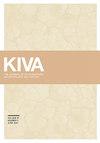An Influx in the Thousands: Late Classic Migration to Perry Mesa
IF 0.4
0 ARCHAEOLOGY
Kiva-Journal of Southwestern Anthropology and History
Pub Date : 2021-09-06
DOI:10.1080/00231940.2021.1962642
引用次数: 0
Abstract
At the time when prehistoric populations were uprooting and relocating themselves across much of the Southwest, an influx of thousands of immigrants possibly arrived onto the elevated and windswept terrain of Perry Mesa in central Arizona. During the Late Classic (A.D. 1280–1400), the expanded populations built large and imposing pueblos equally spaced along the mesa edge and overlooking 1000-foot cliffs. How so many people moved to Perry Mesa in late prehistory is a question we address with survey and ceramic analyses. We assess three migration scenarios: (1) a rapid deployment of a large population en masse for defense; (2) a prolonged migration stream, whereby newcomers steadily arrived to join founder groups, and (3) a scenario that truly was not a migration at all, but rather a local reorganization including the construction of the big pueblos. We also consider how the Perry Mesa case contributes to theory building for migration processes.成千上万的涌入:向佩里梅萨的晚期经典移民
当史前人类在西南部的大部分地区连根拔起并重新安置自己时,成千上万的移民涌入亚利桑那州中部的佩里梅萨高地和狂风肆虐的地形。在古典晚期(公元1280-1400年),扩张的人口沿着平顶山边缘建造了巨大而壮观的普韦布洛村庄,这些村庄可以俯瞰1000英尺高的悬崖。史前晚期有这么多人搬到佩里梅萨,这是一个我们通过调查和陶瓷分析来解决的问题。我们评估了三种迁移情景:(1)大规模人口快速部署用于防御;(2)一个长期的移民流,新移民稳定地来到这里加入创始人群体;(3)一个真正的场景,根本不是移民,而是一个地方重组,包括大普韦布洛人的建设。我们还考虑佩里梅萨案例如何有助于移民过程的理论建设。
本文章由计算机程序翻译,如有差异,请以英文原文为准。
求助全文
约1分钟内获得全文
求助全文
来源期刊
CiteScore
0.70
自引率
33.30%
发文量
31

 求助内容:
求助内容: 应助结果提醒方式:
应助结果提醒方式:


